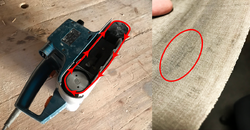Sanding Belts: Difference between revisions
From CoMakingSpace Wiki
(some text from "Belt Sander"; InfoBox) |
(similar) |
||
| Line 9: | Line 9: | ||
|material=[[wood]], [[metal]] | |material=[[wood]], [[metal]] | ||
|used with=[[Belt and Disc Sander|belt and disc sander]], [[Belt Sander|belt sander]] | |used with=[[Belt and Disc Sander|belt and disc sander]], [[Belt Sander|belt sander]] | ||
|similar=[[Sanding Discs|sanding discs]], [[sandpaper]] | |||
}} | }} | ||
If the belt often slips under pressure, it may have become stiff - this may be fixed by "massaging" it a bit in tight bends or replacing it with a new one. | If the belt often slips under pressure, it may have become stiff - this may be fixed by "massaging" it a bit in tight bends or replacing it with a new one. | ||
Latest revision as of 16:57, 3 March 2024
| ToolInfoBox Sanding Belts | |
|---|---|

| |
| Synonyms: | DE: Schleifbänder |
| Type: | power sanding medium |
| Material: | wood, metal |
| Used with: | belt and disc sander, belt sander |
| Location: | wood workshop |
| Similar (More or Less): | sanding discs, sandpaper |
If the belt often slips under pressure, it may have become stiff - this may be fixed by "massaging" it a bit in tight bends or replacing it with a new one.
The belt of a belt sander is often directional. Make sure to install it in the correct direction (see illustration) otherwise it will get damaged quickly.
Newer belts may not have such an arrow indication the direction: due to modern splicing techniques, you can run those belts both ways.
